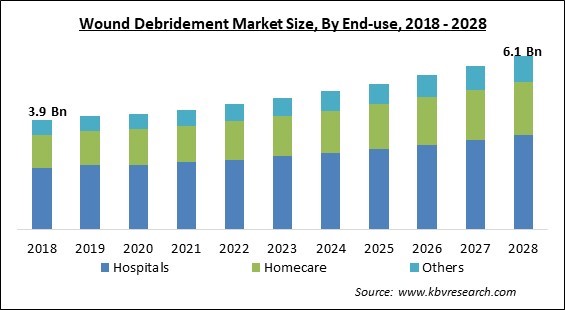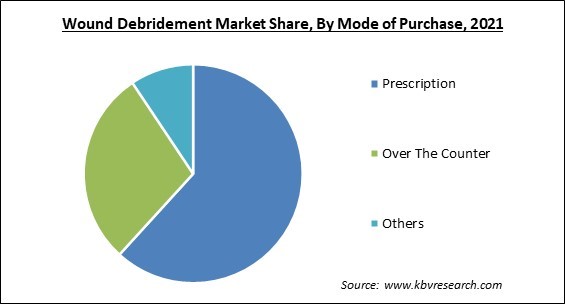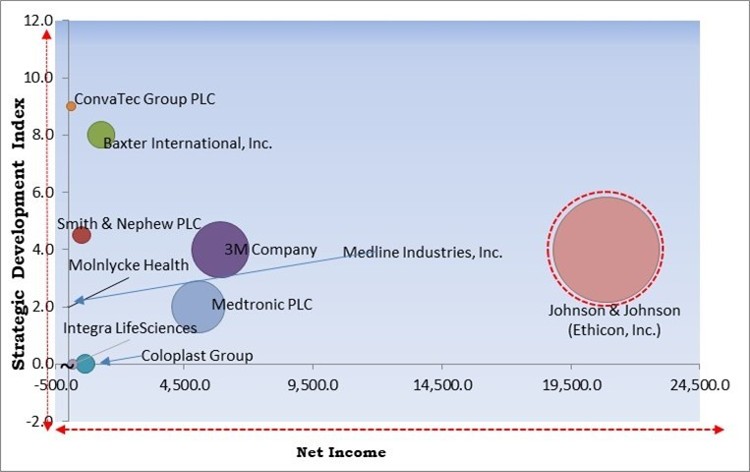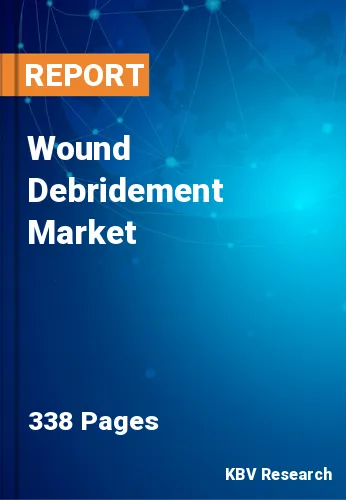The Global Wound Debridement Market size is expected to reach $6.1 billion by 2028, rising at a market growth of 5.5% CAGR during the forecast period.
Wound debridement is defined as the removal of damaged, dead, and infected tissue that has thickened, deformed to callus, or is nonviable. The removal of such tissues is necessary for increasing the healing capabilities of remaining healthy tissues. The main objective of wound debridement is to successfully remove all of the dead and damaged tissue from the wound bed.

This process of tissue removal can also be used to remove bioburden, biofilm, and senescent cells and needs to be conducted at each encounter. In the debridement process, a wound management process that is more than a decade old, the chronic wound bed is prepared to facilitate reepithelialization.
In general, four steps in the order of DIME are followed for better preparation of the wound bed. The acronym DIME stands for Debridement of dead tissues, management of Infection and Inflammation, Moisture control, Epithelialization and Environmental assessment. These four steps of DIME are a well-recognized approach to chronic wound management from which a better comprehensive pathway can be started to facilitate wound resolution.
Debridement is an essential part of wound bed preparation for reepithelialization. The removal of devitalized tissue, in particular, the necrotic tissues, is necessary as such tissues become a significant nutrient source for bacteria. The growth of bacteria at the wound site hinders the healing process. Additionally, devitalized tissue also disrupts reepithelialization by posing as a physical barrier for it, thereby preventing the direct contact of applied topical compounds with the wound bed.
Granulation tissue formation, angiogenesis, normal extracellular matrix, and epidermal resurfacing formations are also prevented by the necrotic tissue. Furthermore, necrotic tissue also contains the accurate assessment of the wound’s severity and extent and may mask any underlying infections.
The pandemic had a negative impact on the entire world and the wound debridement market, with effects more pronounced in the healthcare sectors in emerging and underdeveloped nations. The forced cancellation of numerous medical treatments, including surgery, resulted in most hospitals reaching their maximum capacities. For local manufacturers, the pandemic opened up a wide range of prospects. However, significant businesses' supply chains continued to be impacted as a result of the limitations on transportation at international borders. In addition, medical supplies used in wound debridement were available in limited supply due to the increase in cases. This prompted many regional manufacturers to expand production to keep up with demand.
The focus of many manufacturers is shifting to incorporate advanced technologies in the various processes and devices involved in wound debridement procedures. This has increased the number of investments in the R&D of innovative materials and methods. As a result, numerous advanced therapies have been developed that aim to provide better effects than the current most used therapies like negative pressure therapies and bioengineered & biological therapies. Hence, such R&D activities increase the number of options available for treatment and, therefore, provide lucrative growth opportunities for the wound debridement market.
According to studies conducted by the World Health Organization (WHO) and International Diabetes Federation (IDF), there are approximately 537 million people suffering from diabetes. The studies by WHO also stated that the age of diabetes’ onset has shifted to the 45 – 64 age bracket, putting individuals in this age group at a higher risk of getting diabetes and chronic wounds. Additionally, the current statistics highlight that by the year 2030, developing countries will have a higher number of diabetics than developed nations.
The high cost of surgical and enzymatic debridement equipment decreases the accessibility of these devices for many low and middle-income nations. In addition, since developing economies have a higher incidence rate of road accidents and injuries, they need more wound management products and devices. But surgical and enzymatic wound debridement interventions have become expensive for many individuals. Additionally, less use of wound debridement devices takes place because of difficulties due to the rising cost of healthcare.
Based on mode of purchase, the wound debridement market is divided into prescription, over the counter, and others. The prescription segment acquired the highest revenue share in the wound debridement market in 2021. The availability of favorable reimbursement policies for the debridement products prescribed by a licensed healthcare practitioner has allowed many to proceed with wound debridement procedures. This is the main factor that is responsible for the growth of this prescription segment.

On the basis of product, the wound debridement market is categorized into gels, ointments & creams, surgical devices, medical gauzes, ultrasonic devices, and others. The gels segment witnessed a considerable growth rate in the wound debridement market in 2021. Gels promote a moist environment around the wound, and therefore, clear hydrogels are prominently used for treating necrotic and sloughy tissues. These are preferred over many other products because of many benefits like less bleeding, less inflammation, safe removal of tissues, and filling of dead space.
Based on method, the wound debridement market is divided into autolytic, enzymatic, surgical, mechanical, and others. The enzymatic segment garnered a promising growth rate in the wound debridement market in 2021. This process is also a selective procedure that only removes necrotic tissue and is a slow process. It utilizes collagenase, a proteolytic enzyme, to debride bacteria, specifically, the Clostridium bacteria. The collagenase enzyme digests the collagen of the necrotic tissue, which facilitates the detachment of the tissue.
On the basis of wound type, the wound debridement market is segmented into pressure ulcers, diabetic foot ulcers, venous leg ulcers, burn wounds, and others. The pressure ulcers segment recorded a remarkable growth rate in the wound debridement market in 2021. Pressure ulcers (Pus) are also referred to as bed sores and are caused on the skin because of intense pressure. Long-term bed rests and hospital stays are prominent causes of PUs, and generally, most cases are seen among the geriatric population.
Based on end-use, the wound debridement market is fragmented into hospitals, homecare, and others. The hospital segment acquired the largest revenue share in the wound debridement market in 2021. Both the growing hospitals’ number and the increase in the adoption of surgical procedures are the primary factors giving the segment its growth. This also implies that the average hospitalization rates have also increased.
| Report Attribute | Details |
|---|---|
| Market size value in 2021 | USD 4.2 Billion |
| Market size forecast in 2028 | USD 6.1 Billion |
| Base Year | 2021 |
| Historical Period | 2018 to 2020 |
| Forecast Period | 2022 to 2028 |
| Revenue Growth Rate | CAGR of 5.5% from 2022 to 2028 |
| Number of Pages | 338 |
| Number of Tables | 594 |
| Report coverage | Market Trends, Revenue Estimation and Forecast, Segmentation Analysis, Regional and Country Breakdown, Competitive Landscape, Companies Strategic Developments, Company Profiling |
| Segments covered | Mode of Purchase, Product, Method, Wound Type, End-use, Region |
| Country scope | US, Canada, Mexico, Germany, UK, France, Russia, Spain, Italy, China, Japan, India, South Korea, Singapore, Malaysia, Brazil, Argentina, UAE, Saudi Arabia, South Africa, Nigeria |
| Growth Drivers |
|
| Restraints |
|
On the basis of region, the wound debridement market is analyzed across North America, Europe, Asia Pacific, and LAMEA. The North America segment garnered the maximum revenue share in the wound debridement market in 2021. The rising awareness about chronic wounds, along with the well-developed healthcare facilities in the region, are the main reasons that have prompted more people to opt for wound debridement procedures. In addition, the significant rise in heart operations and trauma care in the region have also increased the demand for wound debridement products and practices.
Free Valuable Insights: Global Wound Debridement Market size to reach USD 6.1 Billion by 2028

The major strategies followed by the market participants are Acquisitions. Based on the Analysis presented in the Cardinal matrix; Johnson & Johnson (Ethicon, Inc.) is the forerunner in the Wound Debridement Market. Companies such as 3M Company, Medtronic PLC, and Baxter International, Inc. are some of the key innovators in Wound Debridement Market.
The market research report covers the analysis of key stake holders of the market. Key companies profiled in the report include 3M Company, Coloplast Group, Medline Industries, Inc., Smith & Nephew PLC, Medtronic PLC, ConvaTec Group PLC, Integra LifeSciences Holdings Corporation (Derma Sciences, Inc.), Johnson & Johnson (Ethicon, Inc.), Baxter International, Inc., and Molnlycke Health Care AB.
By Mode of Purchase
By Product
By Method
By Wound Type
By End-use
By Geography
The global Wound Debridement Market size is expected to reach $6.1 billion by 2028.
Rising Research And Development Activities are driving the market in coming years, however, High Costs Of Surgical Debridement Devices restraints the growth of the market.
3M Company, Coloplast Group, Medline Industries, Inc., Smith & Nephew PLC, Medtronic PLC, ConvaTec Group PLC, Integra LifeSciences Holdings Corporation (Derma Sciences, Inc.), Johnson & Johnson (Ethicon, Inc.), Baxter International, Inc., and Molnlycke Health Care AB.
The Medical Gauzes segment acquired maximum revenue share in the Global Wound Debridement Market by Product in 2021 thereby, achieving a market value of $1.4 billion by 2028.
The Diabetic Foot Ulcers segment is leading the Global Wound Debridement Market by Wound Type in 2021 thereby, achieving a market value of $2.3 billion by 2028.
The North America market dominated the Global Wound Debridement Market by Region in 2021, and would continue to be a dominant market till 2028; thereby, achieving a market value of $2.3 billion by 2028.
Our team of dedicated experts can provide you with attractive expansion opportunities for your business.

